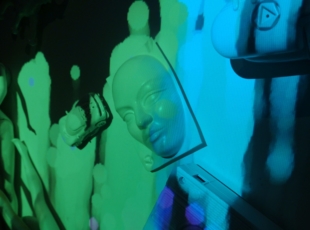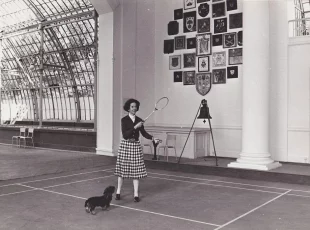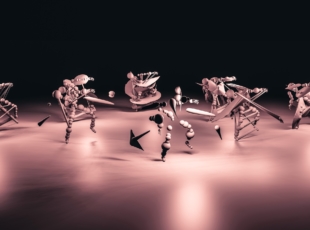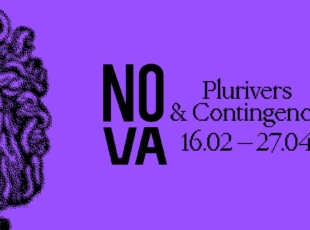Claire Williams, in liaison with the invisible

Article author :
Sound, textile, electronics. By means of the media she is particularly partial to, the artist Claire Williams renders electromagnetic waves material and explores our relationship with imperceptible universes. Fluctuating between the cosmos and our magnetosphere, her installations and her contribution as an artist researcher establish links between the formal, occult and experimental sciences.
Before meeting her in the flesh at the KIKK Festival, where she was on hand to present her installation “Les Télépathes” – to which we’ll return a few lines below – it’s with Claire Williams’ electromagnetic double that we connect through our screen. A graduate of a Master’s degree in Textile Design at La Cambre, Brussels, and the Fresnoy Studio national des arts contemporains in Tourcoing, the artist is currently pursuing a research project on the experimental and occult sciences of the 19th century entitled “Les Aethers”, in collaboration with Dvora Levy. “It was in the second half of the 19th century that the invisible began to be considered. Chemists, physicists, mediums and other scientists immersed themselves in this medium, which some called “ether” and others “fluid”. They spoke of cosmic energies, spirits, vital plant flows… These scientists then devised devices to detect and harness these forces, from the telegraph to the stereometer.
On either side of the border, we trace between sciences and non-sciences, these researchers into the invisible were driven by the same ambition: to reveal an unknown world. To succeed in their goal, it was necessary to share concepts and exchange ideas, a lot of them. And, surprise, surprise, in this abundant ensemble of scholarship, we find a large number of women. They came together in collectives, bringing to light another connection to the body, a more qualitative than quantitative approach to the theories explored. In her research work, Claire Williams is also endeavouring to study and recontextualise the contribution these women made.
Looking history in the eye
In 2021, at the request of the curator of The Missing Page exhibition, held at the Centre Wallonie-Bruxelles in Paris, she wrote a page inserted into the Instruments of Science: An Historical Encyclopaedia. On her portfolio, the Brussels-based artist writes in regard to this: ‘in flicking through scientific encyclopaedias, and the history of telecommunications more specifically, a simple CTRL + F is enough to show the contribution of women to this domain. The “Mrs, Madams, women…” only point to two or three occurrences amongst the hundreds of pages leafed through. They generally refer to the wife of an eminent scientist or to a generous patron. Sometimes it is the name of a transatlantic cable named in honour of the wives of the engineers who installed them. In short, these stories do not talk of the women who contributed to shaping our current electromagnetic landscape. I therefore wrote a page dedicated to them in order to once again include them in our history. Apart from what they have bequeathed us in Western technological history, it is perhaps another form of science they are offering us, a science which we may term queer*.’
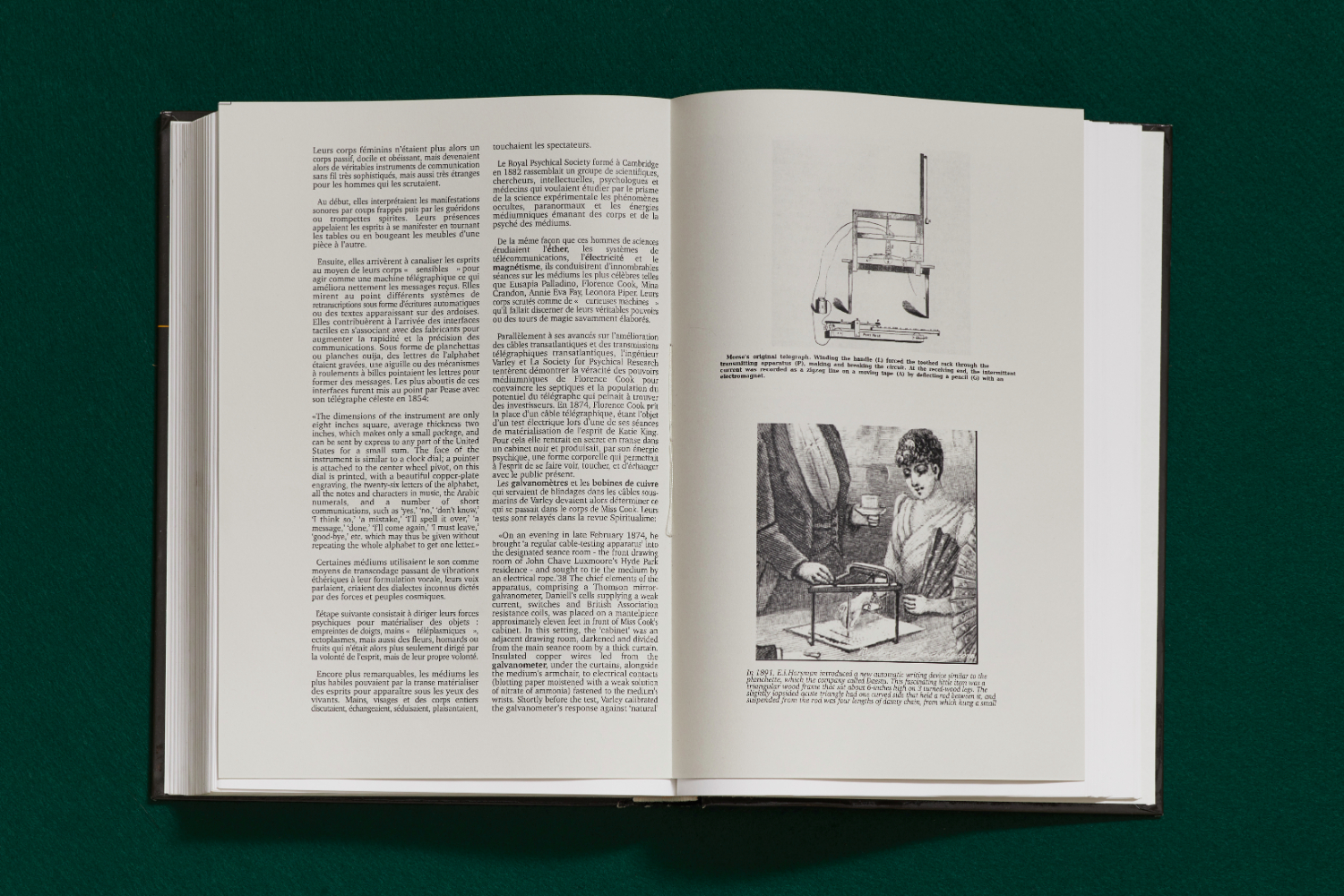
Never far from textile, making use of handicraft processes but also of electronics, her artistic practice tends towards freeing itself from dominant practices within militant and (cyber)feminist spaces. Her commitment to highlighting the heritage of women scientists forgotten by the majority is supported by a single overarching question: ‘what were the technological dreams of these researchers?’ Claire Williams puts forward the hypothesis that with our computers and our smartphones, we have all finally become mediums. All our modern technologies irrefutably have us journeying kilometres through an imperceptible dimension. So many millions of spirits roaming around us, at times endlessly. An apocalyptic vision for some, fascinating for others. In her installation, ‘Les Télépathes’, which she presented at the Capture #2 exhibition, at the Pavillon, the artist for that matter explores the materiality of our consciousness.
In ‘Les Télépathes’, I wanted to create an interface which immerses us in another state of consciousness. And, while we are at it, in the longest phase of adapted consciousness, in other words, a deep coma.
Claire Williams
Towards the noosphere
Under our cranial cavities, our brains are busying themselves. Neuronal activity produces natural electromagnetic waves which can be measured by means of an electroencephalograph. This famous medical helmet fitted with electrodes which play the role of small antennae. ‘Can we consider this psychic activity as a shared materiality?’ wonders Claire Williams. Affirmative. Several scientists such as Vladimir Vernadski have named this the noosphere (as a supplement to the biosphere). ‘We still have no idea of the possible scale of noospheric effects,’ wrote Pierre Teilhard de Chardin (a colleague of Vernadski) in 1955, in Le phénomène humain. ‘The resonance of human vibrations times millions! A whole layer of consciousness pressing on the future at the same time! The collective and additive product of one million years of thought!’ And Claire continues: ‘I find that interesting because in the West we are little inclined to think of this energy as a materiality. In other cultures, dreams have an actual meaning in everyday life, whereas here we clearly distinguish them from the tangible world. Yet, when we dream, we enter another type of reality and we come out of it with quite precise images. In “Les Télépathes”, I precisely wanted to create an interface which immerses us in another state of consciousness. And, while we are at it, in the longest phase of altered consciousness, in other words, a deep coma.’

To conceptualise her idea, the artist has plenty of backup. Books first of all, such as the one she shows us via her webcam. Dream Telepathy, by Montague Ullman, Stanley Krippner and Alan Vaughan. A work dating from 1973, an era when new questions were being raised: could dreams be the manifestation of a heightened state of consciousness in which the dreamer intercepts the thoughts of others? If spontaneous telepathy through dreams exists, is it possible to induce it in experimental conditions? Claire Williams is also in close touch with the neurosciences hub at the ULiège, in particular the COMA Science Group. An international and multidisciplinary team with the goal of advancing research into post-coma states and consciousness disorders. Themes which are much described yet still also taboo within the hard sciences. ‘Altered consciousness, near-death experiences; these subjects trigger debate within the scientific domain, but the ULiège department is prepared to put them on the table. It is one of the first in Europe to do so. A godsend for this artistic project.’
In the Pavillon exhibition hall, ‘Les Télépathes’ rises before us: some fifty or so glass shapes inspired by chemistry instruments and manufactured by science glassware blowers at the Lycée Dorian, in Paris. Under each tubular shape, a bluish light variegates and a magnetized metal ball produces a slight yet clinking sound. The installation builds the portrait of the psychic activity measured for around fifteen minutes in several people in a deep coma. A telepathic device which signals, in the form of perceptible waves this time, a parallel yet collective consciousness. As ever in her artistic process, Claire Williams wishes to give a little meaning to our life on Earth, but also to free herself from imposed viewpoints.
Currently in residency at the Sart Tilman campus of the University of Liège (ULiège), in the nanotechnology department, the artist will be cogitating over the next two months on the fabrication of the invisible. “Today, we’re able to work with matter on atomic scales. We can, for example, engrave the contents of a book on a single strand of hair. When we look at the materials that have always been retained in history, they are often rigid, impermeable, resistant. In this artistic residency project, on the other hand, I’ll be experimenting with materials at the very edge of the visible. Maybe even create a work that will disappear. Who knows.” A foretaste of a future interface with the invisible to be found in March 2024 at Les Drapiers, a contemporary art gallery in Liège.
Who does not adhere to the binarity of genders (feminine versus masculine) and sexualities (heterosexuality versus homosexuality). The original definition of the word in English means “strange, bizarre, out of the ordinary”.

This content is offered within the scope of Propulsion by KIKK, a digital awareness project for and by women.
A story, projects or an idea to share?
Suggest your content on kingkong.

